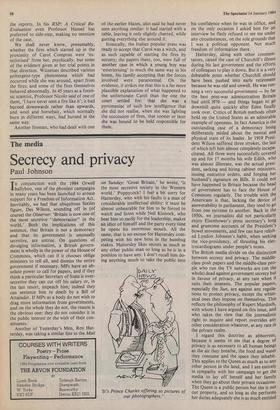Perhaps she was a witch.
Brian Inglis
The court in Livorno which found the Scots nanny Carol Compton guilty of arson has now delivered a written judg- ment which creates an unusual legal prece- dent. It is, I think, the first occasion when a court has taken into consideration the Possibility that there might be a paranormal explanation for arson, or indeed for any crime.
The presiding judge, admittedly, declined to accept the explanation; but this was not because he held that the paranormal, being contrary to the laws of nature, cannot be Pleaded as within the laws of the land something which judges have quite often asserted in the past.
No: his objection was that if Carol was using some psychic force to start up the fires without intending to, why had there not been similar fires before her arrival in Italy, or while she was in jail? Here, the judge was displaying an Understandable lack of knowledge of Previous cases of the kind, usually at- tributed to poltergeist activity. They are commonly related to an individual who ap- pears to have built up a charge of psychic energy which explodes around him, or her, in various ways, hurling crockery around, Making banging noises, and lighting up fires. But often they cease when the in- dividual is moved to a different environ- ment, another house or another job.
'Poltergeist' is an unsatisfactory term, Implying as it does the existence of a mischievous spirit; but we are stuck with it (unlike the Germans, who now prefer sPuk), because it is highly improbable that the alternative jargon term favoured by some parapsychologists, 'recurrent spon- taneous psychokinesis', is going to acquire colloquial status. Nor should it, as Poltergeist phenomena are usually far from spontaneous, one of their distinguishing Characteristics being that they appear to be Produced by a crafty intelligence. Paradoxically, although the phenomena are often hard to credit — showers of rain indoors; fragile objects flying through the air as if immune to the effects of gravity, turning corners, and falling gently, without breaking, on stone floors — they are also exceptionally well-documented. This is Partly because they go on for weeks, or
months, making it possible to investigate them systematically (though poltergeists en- joy teasing investigators); and partly because they can often be seen, and sometimes photographed.
As a result, there are scores of well- attested cases, from 'the demon drummer of Tidworth' in the 17th century — the first case to be seriously investigated, by the far from credulous Joseph Glanvill, one of the early Fellows of the Royal Society — down to 'the Rosenheim poltergeist', the most striking of recent hauntings.
It took place in a lawyer's office in that Bavarian town. Because it appeared to be the work of a practical joker — lights fus- ed, filing cabinets moved around, their con- tents being scattered, a huge telephone bill run up .- the police were called in, along with investigators from the electricity company, and the telephone company and eventually, when no culprit could be traced, two physicists from the Max Planck In- stitute, who installed sophisticated monitoring devices, along with tape- recorders and video cameras. The monitor- ing equipment conclusively demonstrated, they finally had to admit, that the effects 'defied explanation in terms of current physical theories'.
The report added that the effects 'gave the impression of being under intelligent control, and had a tendency to evade in- vestigation' (they had tended to occur when nobody was looking — but had sometimes been caught by a camera; once, in turning a picture face to the wall). Reluctant though all concerned were to admit that it must be a poltergeist case, the leading authority in Germany on the subject, Professor Bender, was called in, and immediately identified one of the secretaries as the unwitting cause of all the trouble.
She could not have been physically responsible for most of the effects, the monitoring equipment showed. Nor indeed could any human hand have been responsi- ble for some of them: 'surges' in the electric current; telephone calls being registered faster than they could be dialled. Even the most aggressively sceptical of critics have been unable, in the fifteen years since the Rosenheim outbreak, to find any flaw in the reports. In his RSP: A Critical Re- Evaluation even Professor Hansel has preferred to side-step, making no mention of the case.
We shall never know, presumably, whether the fires which started up in the proximity of Carol Compton were 'ex- teriorised' from her, psychically; but some of the evidence given at her trial points in that direction. Witnesses described various poltergeist-type phenomena which had occurred while she was around, apart from the fires; and some of the fires themselves behaved abnormally. In 45 years as a foren- sic scientist, Professor Nicolo said of one of them, 'I have never seen a fire like it'; it had burned downwards rather than upwards, and wool and horsehair, which normally burn in different ways, had burned in the same way.
Another fireman, who had dealt with one of the earlier blazes, also said he had never seen anything similar: it had started with a table, leaving it only slightly charred, while gutting everything else around it.
Ironically, the Italian popular press was ready to accept that Carol was a witch, and as such capable of starting the fires by sorcery; the papers there, too, were full of another case in which a young boy was 'exteriorising' in much the same way in his home, his family accepting that the forces involved were paranormal. On the evidence, it strikes me that this is a far more plausible explanation of what happened to the unfortunate Carol than the one the court settled for: that she was a pyromaniac of such low intelligence that she did not realise, when she was lighting the succession of fires, that sooner or later she was bound to be held responsible for them.







































 Previous page
Previous page